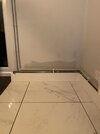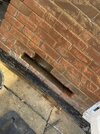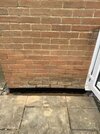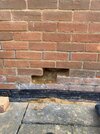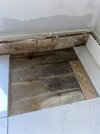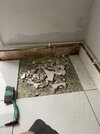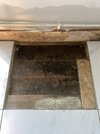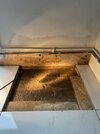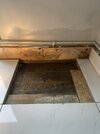Hello, I am hoping someone will have some ideas/insight into solving my damp issue, a damp patch started appearing about a year ago and has been slowly growing ever since, as you can see by the photos it is very obvious.
I haven't got much knowledge at all with building works however I will have a go at anything, the house initially had some damp at low level around the walls but nothing major, the walls in this room were then all replastered around 3 years ago, I injected a DPC cream from permagard around the permiter of the house as you can see in the photos (outside) from where the holes have been plugged. The patio slabs were also butted up against the brickwork, so I have cut all these back 100mm, dug down, cleaned the brickwork and painted with bitumen below the old DPC level, then concreted it with a slope down towards the drain/gully round the corner, then filled with slate, as an attempt to get some better drainage around the house.
So after all this work, I still had this damp patch slowly appear inside, I then resorted to taking out some of the bricks outside to look inside the void and clear any debris or anything that may bridge the DPC, filled up a full bucket of dirt/grit/debris from inside the void but nothing noticeably damp, I then put the bricks back as you can see in the photos, so after all this, the patch still continues to grow...any other ideas would be greatly appreciated!? My next idea was to take up the floor and look underneath the suspended floor, as you can see I have large tiles so I was hoping it wouldn't come to this as i'm assuming i'd probably end up breaking a tile trying to get it out, but it remains a mystery for me, so any guidance I would be very grateful for!
Thank you in advance
I haven't got much knowledge at all with building works however I will have a go at anything, the house initially had some damp at low level around the walls but nothing major, the walls in this room were then all replastered around 3 years ago, I injected a DPC cream from permagard around the permiter of the house as you can see in the photos (outside) from where the holes have been plugged. The patio slabs were also butted up against the brickwork, so I have cut all these back 100mm, dug down, cleaned the brickwork and painted with bitumen below the old DPC level, then concreted it with a slope down towards the drain/gully round the corner, then filled with slate, as an attempt to get some better drainage around the house.
So after all this work, I still had this damp patch slowly appear inside, I then resorted to taking out some of the bricks outside to look inside the void and clear any debris or anything that may bridge the DPC, filled up a full bucket of dirt/grit/debris from inside the void but nothing noticeably damp, I then put the bricks back as you can see in the photos, so after all this, the patch still continues to grow...any other ideas would be greatly appreciated!? My next idea was to take up the floor and look underneath the suspended floor, as you can see I have large tiles so I was hoping it wouldn't come to this as i'm assuming i'd probably end up breaking a tile trying to get it out, but it remains a mystery for me, so any guidance I would be very grateful for!
Thank you in advance


